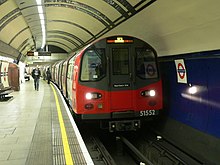Northern Line
| Northern line | |||
|---|---|---|---|
 |
|||
| Overview | |||
| Type | Deep Tube | ||
| System | London Underground | ||
| Stations | 50 | ||
| Ridership | 252.310 million passenger journeys (2011/12) | ||
| Colour on map | Black | ||
| Website | tfl.gov.uk | ||
| Operation | |||
| Opened | 1890 | ||
| Depot(s) | Golders Green, Morden; sidings at Edgware, Colindale, Hampstead, Chalk Farm, High Barnet, East Finchley, Archway, Camden Town, Euston (Bank branch), Moorgate, Charing Cross, Kennington, Tooting Broadway | ||
| Rolling stock |
6 cars per train set |
||
| Technical | |||
| Line length | 58 km (36 mi) | ||
| Track gauge | 1,435 mm (4 ft 8 1⁄2 in) | ||
| Operating speed | 45mph | ||
|
|||
The Northern line is a London Underground line, coloured black on the Tube map. The section between Stockwell and Borough opened in 1890, and is the oldest section of deep-level tube line on the network.
For most of its length it is a deep-level tube line. There were about 252,310,000 passenger journeys in 2011/12 on the Northern line, making it the second-busiest line on the Underground. (It was the busiest from 2003 to 2010.) It is unique in having two different routes through central London – the Charing Cross or West End branch, serving the central part of zone 1, and the Bank or City branch, serving the eastern part of that zone. Despite its name, it does not serve the northernmost stations on the network, though it does serve the southernmost station (Morden), as well as 16 of the system's 29 stations south of the River Thames. There are 50 stations on the line, of which 36 have platforms below ground.
The line has a complicated history, and the current complex arrangement of two northern branches, two central branches and the southern branch reflects its genesis as three separate railway companies, combined in the 1920s and 1930s. An extension in the 1920s used a route originally planned by a fourth company. Abandoned plans from the 1920s to extend the line further southwards, and then northwards in the 1930s, would have incorporated parts of the routes of two further companies. From the 1930s to the 1970s, the tracks of a seventh company were also managed as a branch of the Northern line. An extension from Kennington to Battersea is now under construction, which may either give the line a second southern branch to go with its two northern and central branches, or may see the line split into two distinct lines with their own identities.
The core of the Northern line evolved from two railway companies: the City & South London Railway (C&SLR) and the Charing Cross, Euston & Hampstead Railway (CCE&HR).
The C&SLR, London's first deep-level tube railway, was built under the supervision of James Henry Greathead, who had been responsible, with Peter W. Barlow, for the Tower Subway. It was the first of the Underground's lines to be constructed by boring deep below the surface and the first to be operated by electric traction. The railway opened in November 1890 from to a now-disused station at King William Street. This was inconveniently placed and unable to cope with the company's traffic so, in 1900, a new route to Moorgate via Bank was opened. By 1907 the C&SLR had been further extended at both ends to run from Clapham Common to Euston.
...
Wikipedia
